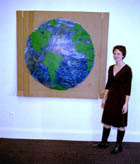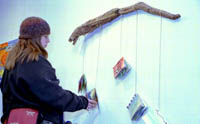The art exhibit “Thanatos” shouts its message through paint and discarded everyday items such as trash bags and string. It displays the psychological dimensions of the environmental crisis.
“I see life as following your heart and this is what’s in my heart,” says Creighton Burson of her show that opened Friday, Jan. 17 in the Orleans Room lobby of the Danna Center.
Burson’s message is this: “You need to be conscious of how you interact with your environment.”
“We’re doing it in a dangerous way and things should change,” she said.
This is Burson’s opening exhibit, and it includes several paintings and sculptures that use pictorial images to convey concern about environmental issues.
Burson, psychology senior and environmental studies minor, became interested in Environmental Studies while taking professor Francis Coolidge’s environmental philosophy class. Coolidge is an associate professor in the Department of Philosophy at Loyola.
For her final exam in Coolidge’s class Burson did a painting titled, “What Are You Scared Of?” and a nine-page paper about the piece.
“This was the first opportunity I grasped to express my concern for the environment with a media that defied barriers of language,” Burson says. “Art opened the door.”
Burson was interested in an environmental studies minor, but hesitated at how to go about completing the fieldwork it required. The minor requires 120 hours of practicum, internship or any type of “in the field” experience.
It was while taking “Environmental Ethics” that Burson met Jacqueline Bishop, an ecological artist and guest professor at Loyola. Bishop teaches “Art and the Environment” as part of the environmental studies and visual arts programs.
Burson asked Bishop to be her mentor. Bishop accepted and they began a project creating psychological dimensions of the environmental crisis. Burson had no previous training in art before the project.
“Nothing like this had ever before been done. I just followed my thoughts and this is where I finished,” Burson said.
Throughout the creation of her artwork and research, Burson kept a running dialogue with Bishop through a journal.
The journal, filled with questions and answers, newspaper articles, pictures and paintings kept a focus on the project. Within its pages Burson and Bishop discussed environmental ethics, philosophy, art, current events, expeditions and art as communication and expression. The journal now sits atop a severed tree trunk as part of a piece titled “Dialogue”.
Burson finished her fieldwork with over 180 logged hours, including time spent painting and researching over the summer. She lived for two weeks on a J/24 sailboat.
“Since the project was about water in the beginning, I felt it was necessary to immerse myself in the field of what I was studying,” she says. “Having a strong interest in sailing allowed me a way to exchange skill for inspiration. Crewing on a variety of racing sailboats put me in the middle of Lake Ponchartrain to as far as Fort Walton and Pensacola, Florida.
“The project is still about water, but it expanded to more dimensions than I thought I could imagine,” she says.
As a sailor, Burson felt tied to water issues. She did a lot of reading into environmental issues to help fuel and direct her pieces. “This is just my way of communicating the message,” Burson says.
One piece in the exhibit is a thick branch of driftwood hung horizontally. Wire-bound water-colored paper books are suspended from it. The books are filled with drawings and mixed media quotes. “No time for politics,” states one book.
“False Security” depicts the Earth being held up in two hands, while the figure of a person dangles from the earth by a single string.
“A false sense of control over the environment shall lead humankind to great harm,” states the information plaque below the painting.
“Autonomy Is Madness” is described only with a quote by Theodore Rorzak, the founder of Ecological Psychology.
“Sanity is a matter of balance and reciprocity between humans and non-humans. Humans must establish a transactional bond with the natural,” he says.
“Empty Dreams,” a burned-out light bulb set in the mouth of a gas can, shows the illusion of infinite resources.
“Samsara,” is a sculpture of dead plants and animals that have been given a new life through their part in the art piece.
Burson says she isn’t sure what course she will pursue when she graduates in May. She plans to travel in Europe, especially Italy, and then return to New Orleans to continue training at UK Sailmakers, repairing sails and canvas work.
Burson’s favorite piece in the show is titled “The World is What You Make It,” a large 3-D representation of the earth made of a clear trash bag stuffed with blue grocery bags, and mounted on a piece of discarded cardboard. The green continents are spray-painted onto the plastic.
Burson says she feels that the piece conveys the essential messages of the show. She describes it as a pictorial description of the message: the Earth is made out of what we put into it.
“If you can see, it is enough for me,” Burson says.
“Thanatos” is on display through Feb. 7.

Creighton Burson stands with her favorite piece titled, “The World is What You Make of It.” (Ann Hermes)






